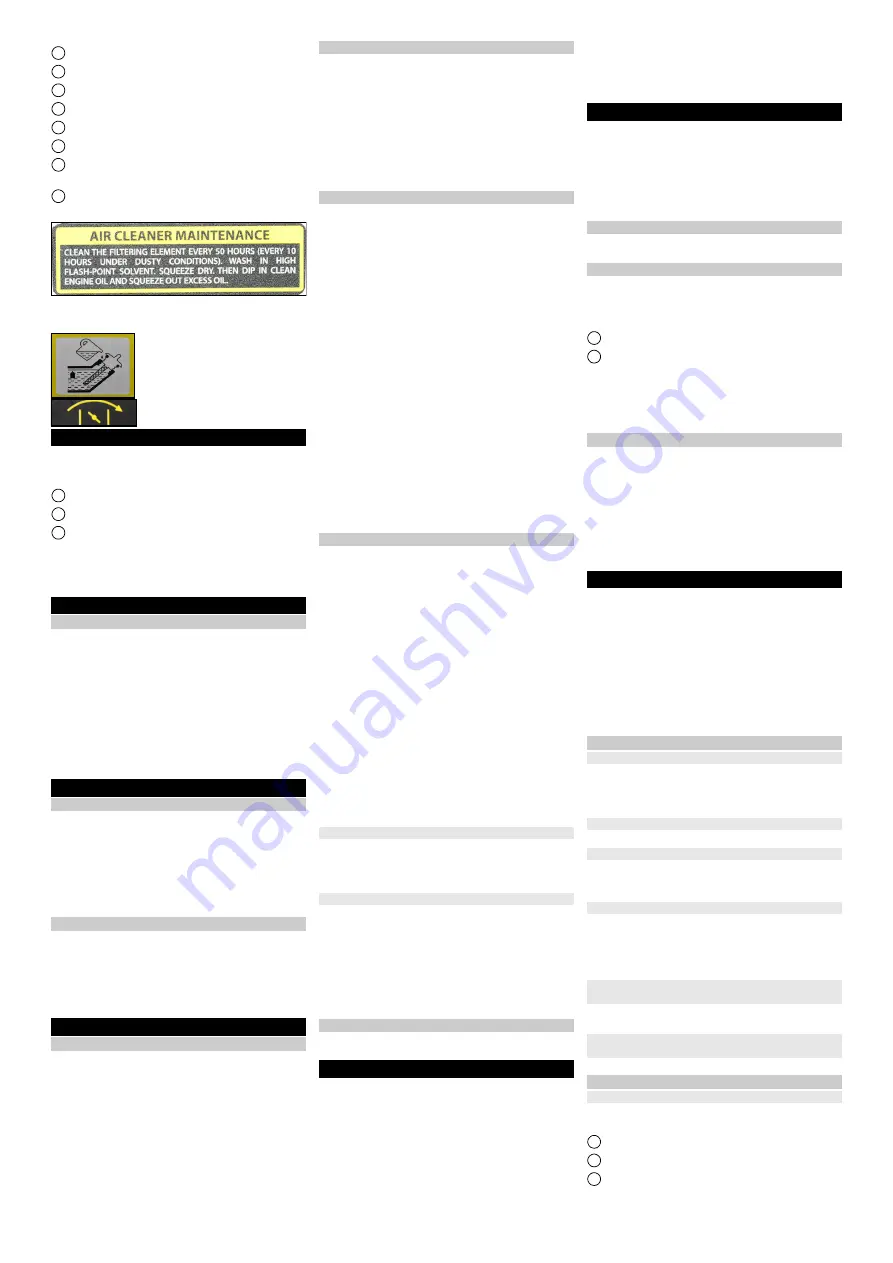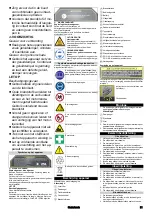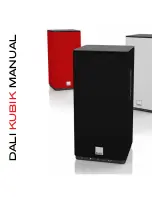
English
9
15
Engine key-operated switch
16
DC circuit breaker
17
DC terminals
18
AC voltmeter
19
Power circuit breaker
20
AC power socket
21
PGG 6/1: AC power socket
PGG 8/3: Three-phase socket
22
Earthing terminal
Symbols on the device
Clean the air filter every 50 operating hours or every 10
operating hours in the case of dusty environments(see
"Care and maintenance/Cleaning the air filter").
Note on checking the oil level.
Choke lever
Installation
1. Mount the push handle on the device frame using
the mounting materials provided.
Illustration B
1
Push handle
2
Stands
3
Wheel
2. Mount the wheels on the device frame using the
mounting materials provided.
3. Mount the stands on the device frame using the
mounting materials provided.
Initial start-up
Fill with oil
1. Position the device on a level surface.
2. Unscrew the oil dipstick.
3. Fill with engine oil.
Note:
The engine oil is not included in the scope of
delivery. The filling quantity and oil type are speci-
fied in the section "Technical data".
4. Wipe off the oil dipstick.
5. Insert the oil dipstick as far as it will go, but do not
screw in.
6. Pull out the oil dipstick. The oil level must lie in the
marked section of the oil dipstick.
7. Top up the engine oil if the level is too low.
8. Screw in and tighten the oil dipstick.
Initial startup
Check the oil level
1. Position the device on a level surface.
2. Unscrew the oil dipstick.
3. Wipe off the oil dipstick.
4. Insert the oil dipstick as far as it will go, but do not
screw in.
5. Pull out the oil dipstick. The oil level must lie in the
marked section of the oil dipstick.
6. Top up the engine oil if the level is too low.
7. Screw in and tighten the oil dipstick.
Refuelling
1. Read the fuel level indicator.
2. Refill the fuel tank with the tank indicator shows a
low filling level.
3. Unscrew the fuel tank cap.
4. Fill fuel up a maximum of the lower edge of the filling
nozzle.
5. Fit the fuel tank cap and screw tight.
Operation
Starting the device
1. Open the fuel cock.
2. Push the choke lever to the left if the engine is cold.
3. Turn the key-operated switch to the START position
and hold in this position until the engine starts. Hold
the key-operated switch in the START position for
no longer than 5 seconds. Wait for at least
10 seconds before attempting to start again.
4. Allow the key-operated switch to return to the 1/ON
position when the engine has started.
5. Push the choke lever to the right once the engine
has started.
Starting with the pull cord starter
1. Open the fuel cock.
2. Push the choke lever to the left if the engine is cold.
3. Pull the starter cord slowly until a strong resistance
is discernible then pull strongly.
4. Slowly return the starter cord.
ATTENTION
Risk of damage
A rapidly returning starter cord damages the device.
Slowly return the starter cord.
5. Push the choke lever to the right once the engine
has started.
Connecting AC devices
The power consumption of the electrical device must
not exceed the continuous power rating of the genera-
tor. The maximum power may only be used for brief pe-
riods. Devices with electric motors require several times
the nominal power when starting up.
DANGER
Danger of electric shock
Electricity can flow through the operator and cause
death or injuries if the electrical equipment or cables are
damaged.
A fault current protection device (PRCD Portable Resid-
ual Current Device) must be connected between each
additional device and the generator if more than one de-
vice is plugged into the generator.
1. Start the generator.
2. Set the power switch to 1/ON.
3. Plug the mains plug of the electrical device into the
socket of the generator.
4. A fault current protection device (PRCD Portable
Residual Current Device) must be connected be-
tween each additional device and the generator if
more than one device is plugged into the generator.
5. Start the electrical device.
If the device does not function correctly, e.g. irregu-
lar running or misfires, immediately switch off and
unplug the connected appliances and investigate
the cause.
Charging vehicle batteries
The 12 V DC connection is only suitable for charging 12
V lead-acid automobile batteries. This connection is not
suitable for use as a 12 V power supply for electrical ap-
pliances.
1. Disconnect the vehicle minus cable (black) from the
battery.
2. Connect the plus terminal (red) of the charging ca-
ble to the plus terminal of the battery.
3. Connect the plus terminal (red) of the other end of
the charging cable to the red terminal (+) of the gen-
erator.
4. Connect the minus terminal (black) of the charging
cable to the minus terminal of the battery.
5. Connect the minus terminal (black) of the other end
of the charging cable to the black terminal (-) of the
generator.
6. Start the generator.
ATTENTION
Risk of damage.
The vehicle or generator can be damaged during
charging if the vehicle engine is running while charg-
ing the vehicle battery.
Do not start the vehicle while charging the battery.
Circuit breaker
The circuit breaker button pops out and interrupts
charging if an overload occurs.
1. Wait a few minutes and then press the button in
again.
Disconnect the vehicle battery
1. Shut down the generator.
2. Disconnect the minus pole (black) from the genera-
tor.
3. Disconnect the minus terminal (black) from the bat-
tery.
4. Disconnect the plus pole (red) from the generator.
5. Disconnect the plus terminal (red) from the battery.
6. Connect the vehicle minus cable (black) to the mi-
nus pole of the battery.
Switching off the device
1. Turn the key-operated switch to "0/OFF".
2. Close the fuel cock.
Transport
Turn the key-operated switch to 0/OFF and close
the fuel cock before transport.
Push the push handle upwards.
Push or pull the device using the push handle.
Allow the engine to cool down for at least
15 minutes before loading.
Keep the device horizontal during transport to pre-
vent fuel from spilling out.
When transporting in vehicles, secure the device
against rolling away, slipping and tipping according
to the respectively applicable guidelines.
Be aware of the weight of the device during trans-
port.
Storage
몇
CAUTION
Failure to observe the weight
Risk of injury and damage
Be aware of the weight of the device during storage.
ATTENTION
Risk of damage
Do not place any heavy objects on the device.
Store the device in a dry and dust-free place.
Storage duration of 1...2 months
1. Add petrol stabiliser to the fuel tank.
2. Top up the fuel tank.
Storage duration of 2...12 months
Additionally:
1. Close the fuel cock.
2. Place a container under the carburettor.
Illustration C
1
Carburettor
2
Drain screw
3. Unscrew the drain screw.
4. Collect the fuel in the container.
5. Screw in and tighten the drain screw.
6. Empty the settling cup (see "Care and Maintenance/
Cleaning the settling cup").
Storage duration longer than 12 months
Additionally:
1. Unscrew the spark plug.
2. 5...10 cm
3
Add engine oil to the cylinder.
3. Slowly pull the starter cord several times to distrib-
ute the oil in the engine.
4. Screw in the spark plug.
5. Change the oil (see "Care and Maintenance/Chang-
ing the oil").
6. Pull the starter cord slowly until a strong resistance
is discernible.
Care and service
DANGER
Danger of injury from electric shock.
You can be injured by moving parts. The electrical volt-
age generated by the device can kill or injure you.
Remove the spark plug connector and disconnect the
battery before performing any maintenance work.
몇
CAUTION
Danger of burns.
Hot device components cause burns if touched.
Allow the device to cool down before working on it.
* See "Startup" for a description.
** See "Maintenance work" for a description.
Maintenance intervals
Each time before use
1. Check the device for correct condition and opera-
tional safety. Do not start up a damaged device.
2. Check the oil level. *
3. Check the air filter. **
Once after 1 month or 20 operating hours
1. Change the oil. **
Every 3 months or 50 operating hours
1. Clean the air filter. **
Perform cleaning more frequently in a dusty applica-
tion environment.
Every 6 months or 100 operating hours
1. Change the oil. **
2. Clean the settling cup. **
3. Check and clean the spark plug. **
4. Clean the spark catcher (not included in the scope
of delivery). **
Annually by the authorised Customer Service
department
1. Check and adjust the valve play.
2. Clean the fuel tank and fuel filter.
Every 2 years by the authorised Customer Service
department
1. Check the fuel line and replace if necessary.
Maintenance work
Check the air filter
1. Pivot the lock away or unscrew the screw.
Illustration D
1
Screw
2
Cover
3
Air filter insert
Summary of Contents for PGG 3/1
Page 49: ...49 2 m IEC 60245 4...
Page 58: ...58 IEC 60245 4 SAE 10W30...
Page 92: ...92 2 IEC 60245 4...










































